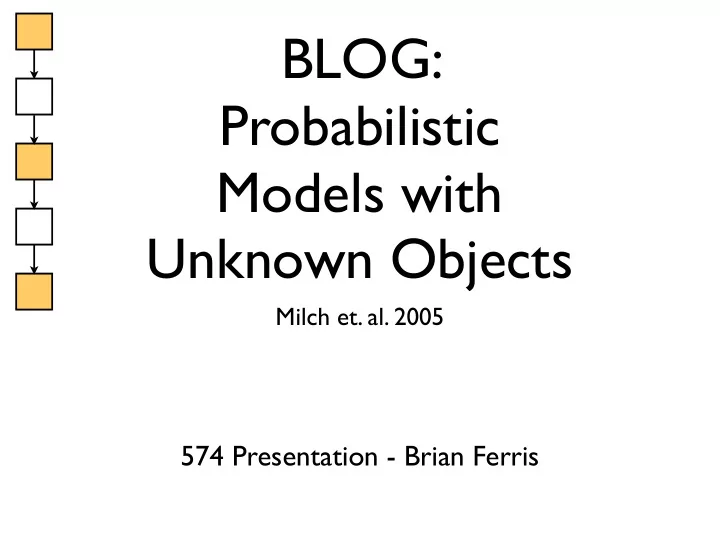

BLOG: Probabilistic Models with Unknown Objects Milch et. al. 2005 574 Presentation - Brian Ferris
Overview • Introduction • Motivating Examples • BLOG: Bayesian Logic • Syntax and Semantics • Inference
Introduction • Existing first-order probabilistic languages attempt to model objects and relationships between them • Such languages have difficulty in modeling unknown objects in a flexible way • There are many interesting problems involving unknown objects
Example I • An urn contains an unknown number of balls, which are equally likely to be blue or green • Balls are drawn, observed (with 0.2 observation error), and replaced • How many balls are in the urn? Was the same ball drawn twice?
Example II • An unknown number of aircraft are being tracked on radar • Each radar blip gives the approximate position of an aircraft, but some blips are false positives, and some aircraft are not detected. • What aircraft exist, and what are their trajectories?
BLOG • A language for defining probability distributions over outcomes with varying sets of objects • Syntax similar to First Order Logic • Describes a stochastic model for generating worlds
BLOG: Example I // Blog is typed type Color; type Ball; type Draw; // Random functions random Color TrueColor(Ball); random Ball BallDrawn(Draw); random Color ObsColor(Draw); // Initial constants guaranteed Color Blue, Green; guaranteed Draw Draw1, Draw2, Draw3, Draw4;
BLOG: Example I // Number of balls has a Poisson prior #Ball ~ Poisson[6](); // Both possible colors of a ball are equally likely TrueColor(b) ~ TabularCPD[[0.5,0.5]]; // Balls are drawn with uniform probability from the urn BallDrawn(d) ~ Uniform({Ball b}); // The observed color of a drawn ball is wrong with P=0.2 ObsColor(d) if( BallDrawn(d) != null ) then ~TabularCPD[[0.8,0.2][0.2,0.8]] (TrueColor(BallDrawn(d))
Syntax and Semantics • In BLOG, everything is treaded as a function : constants are just functions that return true • Functions are typed ( τ 0, τ 1... τ k) where τ 0 is the return type and τ 1... τ k are the argument types
S&S: Types // Object types type Aircraft; type Blip; // Built-in types for strings, numbers, and tuples type String; type R5Vector; • The type keyword introduces the various types for a given model
S&S: Random Functions // Random functions random R6Vector State(Aircraft,NaturalNum); random R3Vector ApparentPos(Blip); • The random keyword introduces a random function of the form τ 0 f( τ 1... τ k) where “f” is the function name, τ 1... τ k are the argument types, and τ 0 is the return type
S&S: Non-Random // Non-Random functions nonrandom NaturalNum Pred(NaturalNum); • The nonrandom keyword introduces a function whose interpretation is fixed in all possible world. • Typing syntax is similar to random functions.
S&S: Dependencies // Dependent function State(a,t) if t=0 then ~ InitState() else ~ StateTransition(State(a,Pred(t))) • Allows a level of flow control for functions • Given example establishes an initial state and subsequent states as transitions from the preceding state
S&S: Generation // Generator functions generating Aircraft Source(Blip) generating NaturalNum Time(Blip) #Aircraft ~ NumAircraftDistrib(); #Blip: (Source,Time) ⇒ (a,t) ~ Detection(State(a,t)) • Most powerful construct that specifies the generation of new objects • A combination of Generator functions and Number functions
S&S: Generation // Generator functions generating Aircraft Source(Blip) generating NaturalNum Time(Blip) #Aircraft ~ NumAircraftDistrib(); #Blip: (Source,Time) ⇒ (a,t) ~ Detection(State(a,t)) • # τ : (g1..gk) ⇒ (x1..xk) ~ DistFunc(x) • g1..gk are functions who accept objects of type τ . • An object of type τ is with P determined by DistFunc(x) when objects o1..ok for g1..gk
Inference • For a given random variable (random function), we consider an instantiation σ over a set of RV vars( σ ) • P( σ ) = ∏ X ∈ vars( σ ) px( σ x | σ pa(X)) ’ • px is the CPD for X • σ pa is σ restricted to parents of X
Inference • In a Bayes Net for a BLOG model, the parent set is often infinite in size
Inference • Self-supporting instantiation • While the parent set may be infinite, not all entries are needed to calculate the CPD • If a given instantiation can be ordered such that Xn depends on only X1..Xn-1 for all n ≤ N, then... self-supporting • See [Milch et al. 2005b] for proof regarding self-supporting instantiations with countably infinite random variables*
Inference • Is this even decidable? • Yes, using rejection sampling • Very slow, but decidable • See termination criteria proof in the chapter • Faster algorithm using likelihood weighting algorithm with backward chaining from the query and evidence nodes to avoid unneeded sampling
Inference • Rejection Sampling • Start with initially empty σ • Augment as function dependencies are met • Continue until all query and evidence variables have been sampled • If consistent, increment Nq • P(Q=q|e) is Nq/N
Results Balls in urn example: 10 balls drawn, all blue, with uniform (a) and poisson (b) priors
Recommend
More recommend